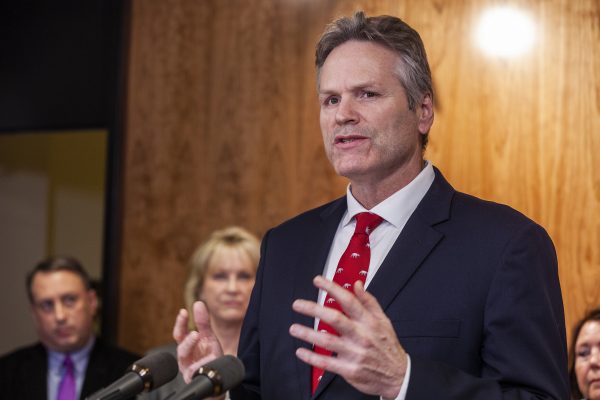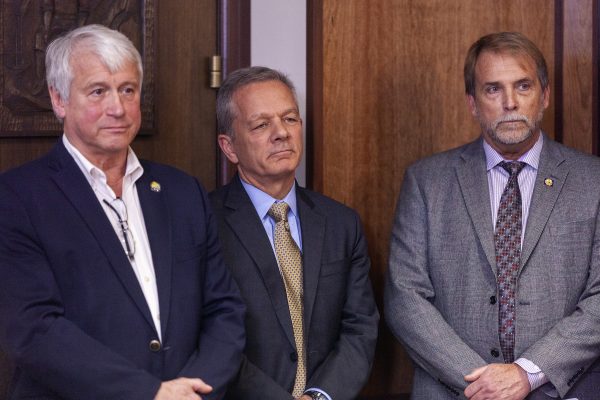
Alaska Republican Gov. Mike Dunleavy proposed a new budget Wednesday that would spend most of the cash left in the state’s primary savings account to sustain government services at status quo levels, while paying out record-sized Permanent Fund dividends.
The proposal would spend $1.5 billion of the $2 billion in Alaska’s Constitutional Budget Reserve, and it represents a profound shift in Dunleavy’s vision for state government — largely abdicating the aggressive budget-cutting approach of his first few months amid legislative opposition and an organized recall campaign.
In his first budget proposal just 10 months ago, Dunleavy pledged to match expenditures with revenues, and to stop “spending wildly” and “kicking the can down the road.”
In that proposal, Dunleavy said that increased spending on Permanent Fund dividends, a major plank in his gubernatorial campaign last year, would be balanced by massive cuts to public schools, the state university system, health care and ferries. Taxes would be avoided.
Related: Our collected coverage of Dunleavy and the budget
But amid a broad public backlash, lawmakers dismissed most of his ideas, cutting the governor’s proposed dividend in half and rejecting many of his proposed reductions.
Over the summer, Dunleavy cut ties to two of his hard-line advisors — former budget director Donna Arduin and former chief of staff Tuckerman Babcock — and his new budget effectively abandons his push to reduce the size of state government. It proposes to spend $10.2 billion, compared to this year’s projected spending of $10.3 billion, holding education, health care and ferry spending flat.
[Read more: Ben Stevens once left the Alaska Senate in disgrace. Now he’s Gov. Dunleavy’s top deputy.]
The new approach from Dunleavy largely eschews the least popular elements of last year’s proposal — the deep spending cuts — while preserving the generous cash payments to Alaskans that he campaigned on. And it hands lawmakers a set of unpalatable political choices in an election year: whether to cut, levy taxes or reduce dividends to preserve the state’s savings accounts, or spend them down to low levels.
At a news conference in Juneau, Dunleavy gave quick introductory remarks, answered a few questions and then left the room, leaving his advisors and commissioners to answer reporters’ questions.
He and his aides suggested that the $1.5 billion deficit could be reduced during the budget process, as the governor’s proposal moves through the Legislature. After Dunleavy’s exit, one of his top advisors, Brett Huber, even left the door open for taxes as a means of closing the gap, saying that “everything is on the table in that discussion.”

The budget, Dunleavy said, “is a springboard for discussions with the Legislature, with the people of Alaska.”
“Because we have to work together to form a budget that’s going to make sense for all Alaskans,” he said.
Dunleavy has not completely foregone his efforts to reduce the size of Alaska’s government.
Dunleavy is still proposing to reduce the budget for the state university system by $25 million, or about 3 percent. And the governor also intends to introduce legislation in an effort to make public schools spending more efficient, the administration said in its written long-term budget plan, also released Wednesday.
Dunleavy’s proposal drew mixed responses. The state hospital and nursing home lobby, spared from the deep cuts to the Medicaid health care program that Dunleavy pushed in his first budget proposal, offered cautious praise: President Jared Kosin said the group was encouraged by the governor’s support for dental care and his “recognition of the importance of Medicaid services.”
But one of the governor’s traditional allies, the conservative Alaska Policy Forum, was skeptical, noting that Dunleavy’s proposal left a “huge gap between revenue and expenditures.”
“Maintaining this level of spending for another year while revenues continue to wane is irresponsible and unsustainable,” said Associate Director Melodie Wilterdink. “We look to the Legislature and governor to identify and executive responsible, sustainable reductions to the budget.”
Leaders of the House’s largely-Democratic majority issued prepared statements Wednesday criticizing the governor’s approach, saying it postponed the tough decisions necessary to fix Alaska’s budget problem and would draw down the Constitutional Budget Reserve to “reckless” levels.
“We agree with the governor’s decision to not further cut the budget. However, spending is only half of the budget, and the governor is deferring to the Legislature on how to pay for it,” said House Speaker Bryce Edgmon, I-Dillingham. “Alaska cannot afford to delay tough decisions another year.”
Related: Anxious about Dunleavy’s new budget? Alaska lawmakers will likely temper it, maybe by a lot.
Dunleavy administration officials said Wednesday’s proposal is not dodging the problem but instead an effort to open a discussion with Alaskans and lawmakers about the best way to close the deficit.
“Rather than unilaterally taking actions that affect the state’s constituents, the governor wants to hear from the people, first,” the administration wrote in the long-term plan.
That plan includes six different scenarios for balancing the budget. Among them are deep spending cuts; levying taxes to allow government to grow at 4 percent a year; cutting dividends; and spending down savings and then either levying taxes or pulling cash from the Permanent Fund’s investment earnings.
The last scenario is what Dunleavy’s administration describes as a “balanced approach,” which includes modest reductions to dividends, and smaller taxes and spending reductions.
“The governor is not endorsing any of these visions for Alaska; rather, he will be spending the coming months engaging with Alaskans to gain a better understanding of the will of the people,” the plan says.
Correction: This story originally misidentified Melodie Welterdink as Alaska Policy Forum’s executive director. She is the organization’s associate director.
Nathaniel Herz is an Anchorage-based journalist. He's been a reporter in Alaska for a decade, and is currently reporting for Alaska Public Media. Find more of his work by subscribing to his newsletter, Northern Journal, at natherz.substack.com. Reach him at natherz@gmail.com.




